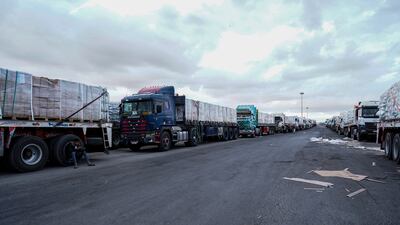Dozens of lorries crossed the Egyptian side of the Rafah border crossing into Gaza on Sunday as work began to dramatically increase aid to the enclave with a ceasefire in its third day.
COGAT, the Israeli agency in charge of humanitarian aid to Gaza, has said the amount of supplies entering the strip is expected to reach around 600 lorries per day, as stipulated in a peace plan put forward by US President Donald Trump.
Egypt said it was sending 400 lorries loaded with supplies into the territory on Sunday. Video footage from Rafah showed dozens of vehicles crossing the Egyptian side of the boundary. The Egyptian Red Crescent said the lorries were carrying medical supplies, tents, blankets, food and fuel, but they will have to be inspected by Israeli forces before being allowed in.
Israeli restrictions on aid and the country's expanded military offensive against Hamas have triggered a hunger crisis in Gaza, including famine in parts of the territory, according to the UN.
The UN said that it has about 170,000 metric tons of food, medicine and other humanitarian aid ready to enter the enclave once Israel gives the green light.
The global body appears to have taken charge of aid deliveries again, after it was sidelined by Israel and the US in favour of the Gaza Humanitarian Foundation, a private contractor backed by the two countries that launched in May.
The GHF had been touted by Israel and the US as an alternative system to prevent Hamas from taking over aid. However, its operations were mired in chaos and hundreds of Palestinians were killed by Israeli gunfire while heading to its sites.
It is unclear what role, if any, the GHF will play in aid distribution moving forward.
The increase in aid comes with preparations under way for the release of Israeli hostages held in Gaza and Palestinian prisoners held in Israel under phase one of Mr Trump's peace plan.
Israeli officials believe about 20 of the hostages out of 48 held by Hamas and other Palestinian factions in Gaza are still alive. All of the living hostages are expected to be released on Monday.
An Israeli military official said the hostages will be transferred by the International Committee of the Red Cross (ICRC) to a special Israel Defence Forces squad.
That squad will then take them to the Reim military base in southern Israel, the official told the BBC.
Family members will be waiting for the hostages at reception points, the official said, adding that they will then travel with them by helicopter to hospitals where they will receive medical treatment.
Mr Trump, who pushed to clinch the ceasefire deal, is expected to arrive in Israel on Monday morning. He will meet families of hostages and speak at the Knesset, Israel’s parliament, according to a schedule released by the White House.
He will then continue on to Egypt, where the office of Egyptian President Abdel Fattah El Sisi has said they will co-chair a “peace summit” with attendance by regional and international leaders.
The exact timing has not yet been announced for the release of around 2,000 Palestinian prisoners held in Israel who are to be freed under the deal. They include 250 people serving life sentences in addition to 1,700 people seized from Gaza during the war and held without charge.
While both Israelis and Palestinians have welcomed the initial halt to the fighting, the longer-term fate of the ceasefire remains murky. Key questions about governance of Gaza and the postwar fate of Hamas have yet to be resolved.
Israeli Defence Minister Israel Katz said in a post to X on Sunday that he had instructed the Israeli military to prepare to begin destroying the network of tunnels built by Hamas under Gaza.
This would be done "through the international mechanism that will be established under the leadership and supervision of the US” once the hostages are released, he wrote.

